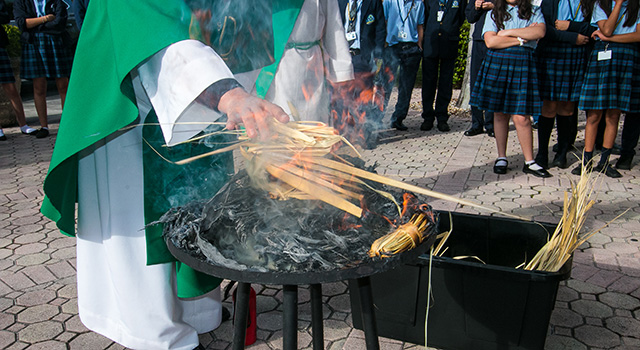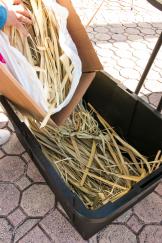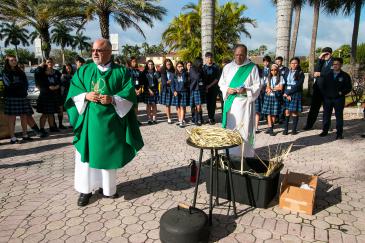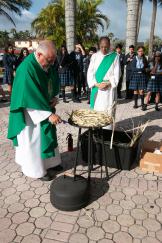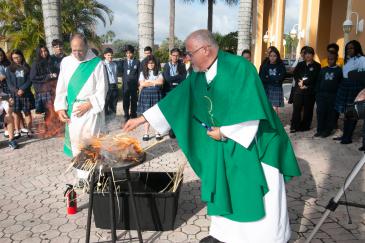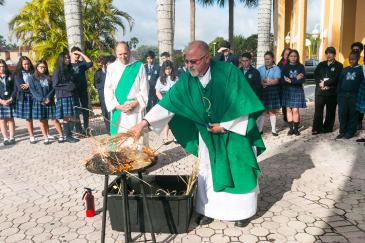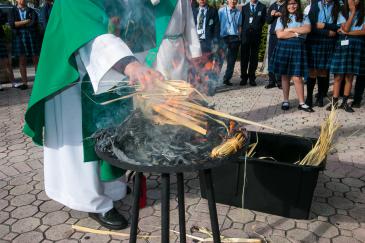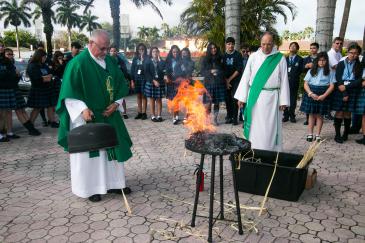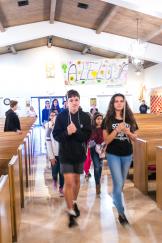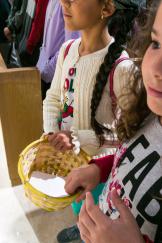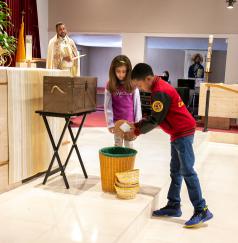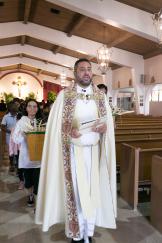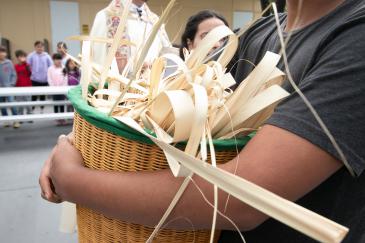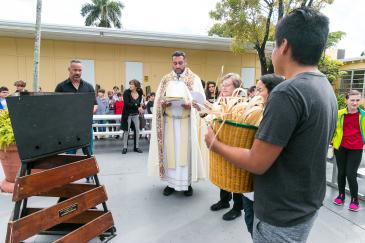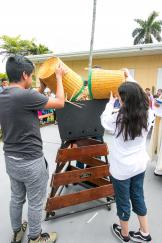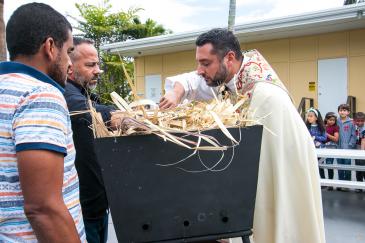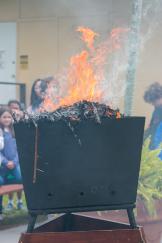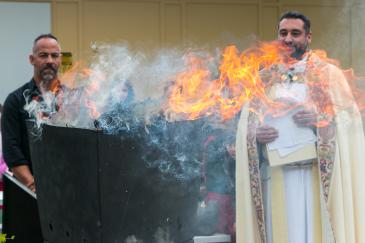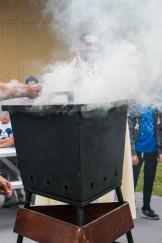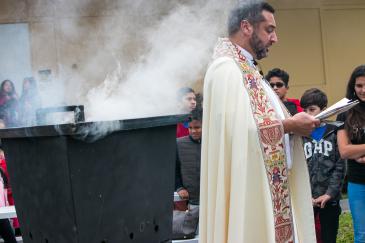By Ana Rodriguez Soto - The Archdiocese of Miami
HALLANDALE BEACH | Last Saturday, they buried the Alleluia at St. Matthew Church — literally.
The children from the religious education program carried an Alleluia banner into church, folded it and placed it inside a small wooden box. The banner will remain there until the Easter Vigil, because the Alleluia will not be heard for the next 40 days.
Then the children went outside and watched as their pastor, Father Robert Ayala, set fire to two basketfuls of palms — the same palms the congregation waved at last year’s Palm Sunday Masses.
The burned palms became the ashes that were distributed at this year’s Ash Wednesday liturgies.
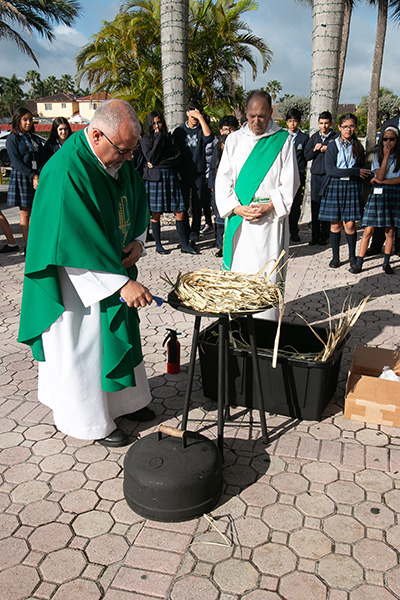
Photographer: ANA RODRIGUEZ-SOTO | FC
Father Juan Hernandez, pastor of Mother of Our Redeemer in Miami, lights the palms as Deacon Orlando Rojo and school children look on.
Turning palms into ashes is not a rite prescribed by the church. It is a purely practical matter that used to be done privately in individual churches, in the same way that the bread for Communion was made — locally.
Father Juan Hernandez, pastor of Mother of Our Redeemer in Miami, remembers in his early days as a priest in Spain, traveling from town to town, parish to parish, and burning the palms or olive branches prior to Lent. It wasn’t a public ceremony, just something done quietly with the sacristan.
Now the speed of modern life and accompanying conveniences mean the palms are burned — and the hosts are made — by monks or nuns who ship them to churches in well-wrapped packages. No smoke. No mess. No stashing palms from year to year.
Many archdiocesan churches buy their ashes from liturgical supply stores. But Father Hernandez and Father Ayala are among a handful of South Florida pastors who have chosen to turn a practical need into an opportunity for catechesis.
This is the second year Father Hernandez does it in his parish, and he did it after morning Mass Feb. 20, right outside the church entrance, in front of sixth, seventh and eighth graders from the parish school.
This is Father Ayala’s first year doing it in public. He explained that he’s done it in private in the past, with the help of his maintenance man. But this year, on Feb. 21, he created a whole ceremony to involve the parish’s religious education students.
“What are we actually burning in those palms?” he explained. “Are we burning just simply the palms? What about if we use it as a symbolism for ourselves as we prepare for Lent? What if I want to burn away things in my life that no longer belong? What if I want to burn away vices that are no longer a part of who I want to be? What if I want to burn away conduct that has maybe alienated me from Christ?”
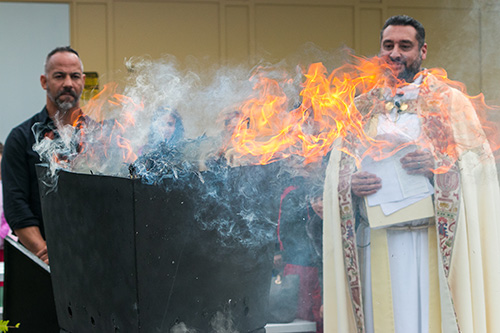
Photographer: ANA RODRIGUEZ-SOTO | FC
Father Robert Ayala, pastor, and students in the religious education program at St. Matthew Church, Hallandale Beach, watch as the palms from last year's Palm Sunday are turned into the ashes for this year's Ash Wednesday.
Turning palms into ashes serves as a reminder of the connection between last year’s Palm Sunday and this year’s Ash Wednesday; between how we welcomed Christ into our lives last year and how we failed to live up to his call since then, said Father Hernandez.
“It’s not the ashes that erase our sins. It’s you, it’s me who must convert, ask the Lord for forgiveness. And when we allow the Lord to enter our lives with his grace, through penance, through the sacrament of reconciliation, then we receive forgiveness.”
Father Hernandez said the ashes represent the reality “that Christ destroys my sin. That I’m dust and to dust I shall return, because one day I will die and have to be buried, but my soul will live on. Then let Christ destroy my sin, our sins, and save us and redeem our souls.”
Turning palms into ashes is a relatively simple process. Take the palms from the previous year — or even older ones — and place them in a metal container. Then set them on fire. Once they turn dark, cover them with a lid to snuff out the fire.
Father Ayala said the lid is the secret. Waiting for the palms to be totally consumed by the fire will give them too white a pallor and too sandy a texture to be placed on people’s foreheads.
The next step is simply to grind them into a sticky powder. Father Ayala said he puts them in a blender. Father Hernandez said he smashes them with a spoon to smooth out the knots, then puts them through a sifter to remove any strands or extraneous particles.
But aside from that, no other ingredients are needed. Just a sprinkle of holy water — to bless them — before distributing them on Ash Wednesday.
“It’s not an obligation to get ashes. It’s neither mortal nor venial sin not to get the ashes. It’s simply a gesture that invites us to prayer, to penance, to receive the Lord’s forgiveness,” Father Hernandez stressed.
For those whose churches use commercially prepared ashes and wonder what to do with palms kept at home over the years, Father Hernandez said they can be burned at home; or tossed or buried in the garden.
Father Ayala had another suggestion: “Bring them to Father Robert. I’ll burn them.”
Photography: ANA RODRIGUEZ-SOTO | FC
